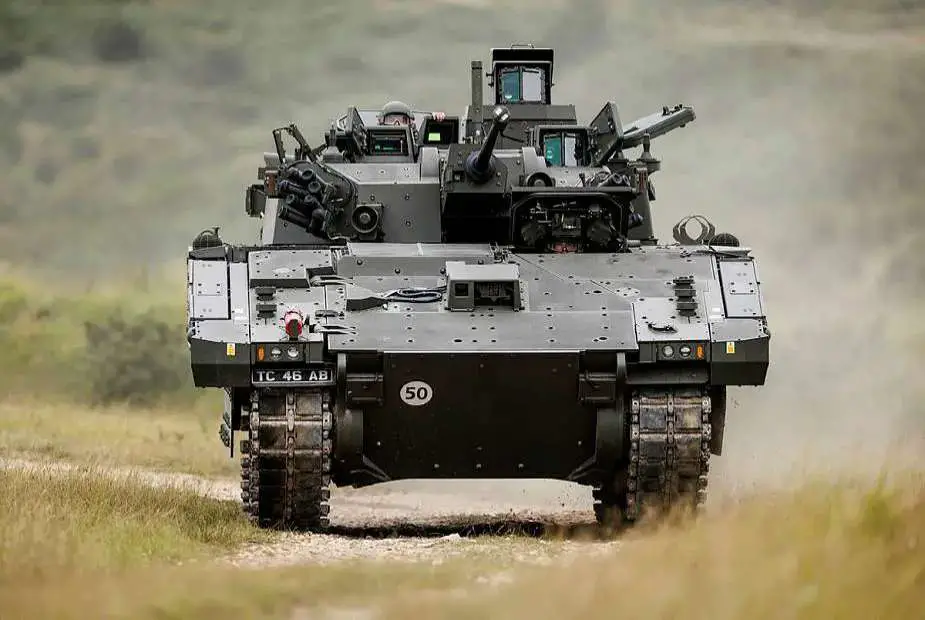Breaking news
British Army's Ajax program progresses despite obstacles.
The British Army's Ajax program, once considered the most significant armored vehicle project in the UK for more than two decades, has faced its share of challenges. The latest update suggests the program is progressing slowly, but serious questions remain.
Follow Army Recognition on Google News at this link

Lockheed Martin UK, a key subcontractor on the program, has announced that it has passed the halfway point in the production of 245 swivel gun turrets for the Ajax IFVs (Picture source: British MoD)
Lockheed Martin UK, a key subcontractor on the program, has announced that it has passed the halfway point in the production of 245 swivel gun turrets for the Ajax IFVs. According to Steve Wallace, production operations manager at Lockheed's Ampthill site in Bedfordshire, the company has manufactured 141 turrets since 2018. Wallace notes that they still have two years of production left to complete the remaining units, but says the company is on schedule.
Originally estimated to cost $4.3 billion, the Ajax program is now expected to reach a cost of $5.5 billion. The delays extended the program's timetable, pushing expected full functionality from 2024 to 2029. These setbacks led to parliamentary calls for the program to be scrapped, although the UK Ministry of Defense (MoD) reiterated its commitment.
A series of setbacks have marked the Ajax program, starting with design flaws revealed in 2021. A leaked document revealed vehicle safety risks, including excessive vibration and noise levels leading to health problems for soldiers. This led to a temporary suspension of payments to General Dynamics, the prime contractor overseeing the assembly of Ajax vehicles. The Public Accounts Committee (PAC) criticized the management of the program and the MoD's decision to choose a "technically unproven and immature 40mm gun".
After acknowledging the problems, the Department of Defense resumed payments to General Dynamics. Lockheed's Ampthill factory also announced that it had resolved issues with the turret component, putting the project back on track. Yet scrutiny remains. Dame Meg Hillier, chair of the PAC, warned: “Enough is enough – the MoD must fix or derail this program before it risks more to our national security and wastes more billions of taxpayers' money. »
While Lockheed Martin's announcement that half of the turret production is complete is a positive sign, the Ajax program is far from out of the woods. It remains to be seen whether the program can overcome its history of delays, cost overruns, and technical problems to meet the British Army's future defense needs.
Since starting trials, Ajax, Apollo, Atlas, and Ares variants have driven over 2,260 kilometers through different terrains, completing a variety of representative battlefield tasks such as operating across a range of speeds and terrains, firing weapon systems, using the vehicle's systems and communications and completing specialist tasks such as vehicle recoveries and repairs using the integrated crane.
The AJAX family of armored vehicles is a series of tracked vehicles developed by General Dynamics UK for the British Army. The AJAX family consists of six variants:
AJAX - a reconnaissance vehicle with a high level of survivability and mobility.
ARES - an armored personnel carrier that can transport troops in and out of the battlefield.
APOLLO - an ambulance vehicle designed to provide medical support to troops in the field.
ATHENA - a command and control vehicle with advanced communications equipment and technology.
ATLAS - an engineering vehicle that can clear obstacles and build bridges.
ARGUS - a recovery vehicle that can recover damaged vehicles and equipment.
Subject to contract amendment, updated schedules direct that Initial Operating Capability will be achieved between July and December 2025, delivering a trained and deployable squadron that can be sustained on operations for up to six months.
Full Operating Capability would follow between October 2028 and September 2029, when the Army has trained and converted forces to the Ajax platform to deliver Armored Cavalry capability to the Deep Reconnaissance Strike Brigade and its two Armored Brigade Combat Teams.
Ajax will deliver a step-change in the surveillance capability for the Army, with its suite of cutting-edge sensors, enhanced 40mm cannon, modular armor, and improved cross-country mobility. The program will provide 589 vehicles that will allow the British Army to operate in all weathers, 24 hours a day.
The AJAX family of vehicles is designed to provide the British Army with a modern, agile, and adaptable fleet of armored vehicles that can operate in a range of different environments. The vehicles are equipped with a range of advanced technologies, including a state-of-the-art digital architecture that enables rapid communication and information sharing between vehicles and soldiers on the ground.
The AJAX family is also designed to provide enhanced protection for soldiers in the field. The vehicles feature a modular armor system that can be adapted to different threat levels and are equipped with advanced situational awareness technology that helps soldiers identify and respond to threats quickly and effectively.
Overall, the AJAX family of armored vehicles represents a significant upgrade to the British Army's armored vehicle fleet, providing soldiers with the tools they need to operate effectively in modern conflict zones.


























